- (785) 979-3636
- Mon - Fri | 9AM - 5PM
We offer seamless gutter installation, gutter repair, gutter replacement, and more to protect your home.

We offer seamless gutter installation, gutter repair, gutter replacement, and more to protect your home.


We only offer one type of gutter: K-style in two different sizes (5″ and 6″). K-style gutters are flat on both the bottom and back side and have a decorative front that resembles crown molding of the front face, as seen in the images below.

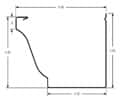
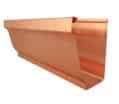
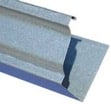
Equally as important as the material and style that you choose are the fasteners that you use to hang your gutter and downspout. We use hidden hangers, as shown in the image to the left, and a minimum of two straps for the downspout per 10′ section.
You will need to determine the pitch of your roof if you want to figure out what gutter size you need. The easiest way is to use a 1′ bullet level. Lay one end on the roof, hold the other end up until you achieve level, and measure down with a tape measure. If you have 4″ between the end of the level and the roof, then you have 4/12 pitch. If you have 9″, then you would have a 9/12 pitch. Once you know what your roof pitch is, you will be able to multiply by the figures shown below.
Roof Pitch
12/12 or higher
9/12 to 11/12
6/12 to 8/12
4/12 to 5/12
Roof Pitch Factor
1.3
1.2
1.1
1.05
According to the U.S. Weather Bureau records, the maximum rainfall that could possibly happen in a 5-minute period, in inches per hour, is 7.4″ per hour (Kansas City, MO). Numbers could vary regionally or locally but this is a good number for a general base line.

5-inch 5,520 square feet
6-inch 7,960 square feet
Now that you know what the variables are, here is the formula to calculate what size guttering you will need based on the size and pitch of your roof.
A = square footage of the roof section
B = roof pitch
C = maximum amount of rainfall per hour (which we know is 7.4)
A x B x 7.4
The section above explains how to determine your gutter size. The section below will explain how to determine your downspout size.
2 x 3 inch rectangular = 600 square feet
3 x 4 inch rectangular = 1200 square Feet
To calculate, you will divide 600 or 1200 by the number you get from the formula determined above. If it’s close you should always err on the side of bigger.

Gutter guards can be a great way to keep your gutter flowing well and free from debris. There are several different options for gutter guards and the section below will review the pros and cons of the different types that we offer.
In the photo below is a basic screen-type gutter guard. They are effective at diverting larger objects that would easily clog your downspout.
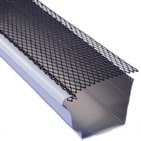
In the photo below is a modified screen-type gutter guard that has the same attributes as the one above, but it is more effective at diverting seed-type debris.
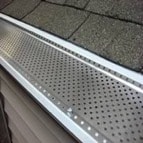
In the photo below is a surface-tension-style gutter guard. Out of all the gutter guards shown, they handle all debris the best if installed correctly.
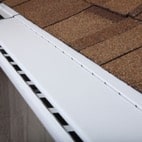
Wood Rot: Replacing soffit and fascia as needed due to wood rot.
Ventilation: Gable vents, soffit vents, or ridge vents.
Painting: Fascia and trim tends to get overlooked during routine house painting.
Drainage: Splash blocks, underground drainage, and gutter extensions.
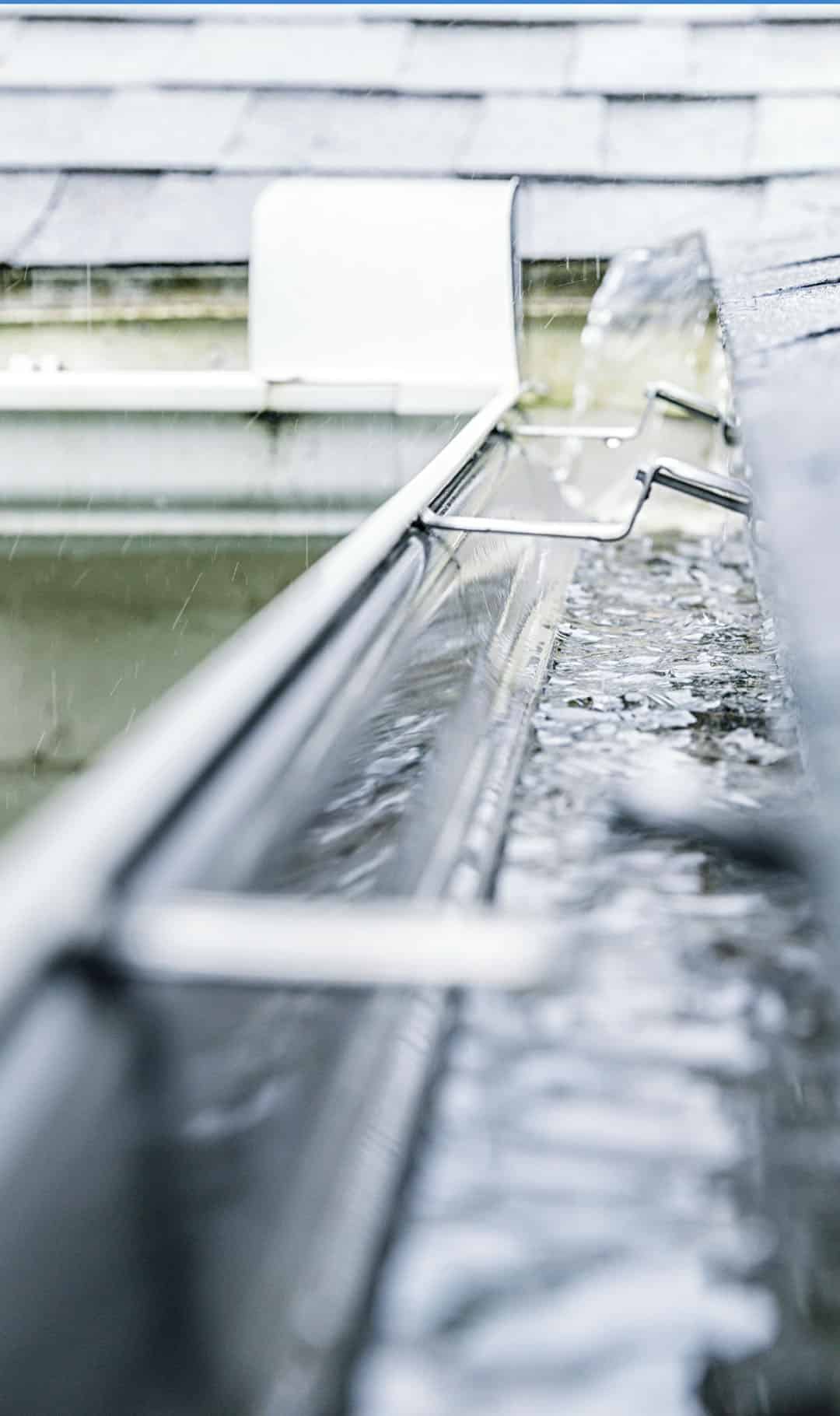
We only offer one type of gutter: K-style in two different sizes (5″ and 6″). K-style gutters are flat on both the bottom and back side and have a decorative front that resembles crown molding of the front face, as seen in the images below.




Equally as important as the material and style that you choose are the fasteners that you use to hang your gutter and downspout. We use hidden hangers, as shown in the image to the left, and a minimum of two straps for the downspout per 10′ section.
You will need to determine the pitch of your roof if you want to figure out what gutter size you need. The easiest way is to use a 1′ bullet level. Lay one end on the roof, hold the other end up until you achieve level, and measure down with a tape measure. If you have 4″ between the end of the level and the roof, then you have 4/12 pitch. If you have 9″, then you would have a 9/12 pitch. Once you know what your roof pitch is, you will be able to multiply by the figures shown below.
Roof Pitch
12/12 or higher
9/12 to 11/12
6/12 to 8/12
4/12 to 5/12
Roof Pitch Factor
1.3
1.2
1.1
1.05
According to the U.S. Weather Bureau records, the maximum rainfall that could possibly happen in a 5-minute period, in inches per hour, is 7.4″ per hour (Kansas City, MO). Numbers could vary regionally or locally but this is a good number for a general base line.
5-inch 5,520 square feet
6-inch 7,960 square feet
Now that you know what the variables are, here is the formula to calculate what size guttering you will need based on the size and pitch of your roof.
A = square footage of the roof section
B = roof pitch
C = maximum amount of rainfall per hour (which we know is 7.4)
A x B x 7.4
The section above explains how to determine your gutter size. The section below will explain how to determine your downspout size.
2 x 3 inch rectangular = 600 square feet
3 x 4 inch rectangular = 1200 square Feet
To calculate, you will divide 600 or 1200 by the number you get from the formula determined above. If it’s close you should always err on the side of bigger.
Gutter guards can be a great way to keep your gutter flowing well and free from debris. There are several different options for gutter guards and the section below will review the pros and cons of the different types that we offer.
In the photo below is a basic screen-type gutter guard. They are effective at diverting larger objects that would easily clog your downspout.

In the photo below is a modified screen-type gutter guard that has the same attributes as the one above, but it is more effective at diverting seed-type debris.

In the photo below is a surface-tension-style gutter guard. Out of all the gutter guards shown, they handle all debris the best if installed correctly.

Wood Rot: Replacing soffit and fascia as needed due to wood rot.
Ventilation: Gable vents, soffit vents, or ridge vents.
Painting: Fascia and trim tends to get overlooked during routine house painting.
Drainage: Splash blocks, underground drainage, and gutter extensions.
We only offer one type of gutter: K-style in two different sizes (5″ and 6″). K-style gutters are flat on both the bottom and back side and have a decorative front that resembles crown molding of the front face, as seen in the images below.



Galvalume

Copper
Equally as important as the material and style that you choose are the fasteners that you use to hang your gutter and downspout. We use hidden hangers, as shown in the image to the left, and a minimum of two straps for the downspout per 10′ section.

You will need to determine the pitch of your roof if you want to figure out what gutter size you need. The easiest way is to use a 1′ bullet level. Lay one end on the roof, hold the other end up until you achieve level, and measure down with a tape measure. If you have 4″ between the end of the level and the roof, then you have 4/12 pitch. If you have 9″, then you would have a 9/12 pitch. Once you know what your roof pitch is, you will be able to multiply by the figures shown below.
Roof Pitch
12/12 or higher
9/12 to 11/12
6/12 to 8/12
4/12 to 5/12
Roof Pitch Factor
1.3
1.2
1.1
1.05
According to the U.S. Weather Bureau records, the maximum rainfall that could possibly happen in a 5-minute period, in inches per hour, is 7.4″ per hour (Kansas City, MO). Numbers could vary regionally or locally but this is a good number for a general base line.
5-inch 5,520 square feet
6-inch 7,960 square feet
Now that you know what the variables are, here is the formula to calculate what size guttering you will need based on the size and pitch of your roof.
A = square footage of the roof section
B = roof pitch
C = maximum amount of rainfall per hour (which we know is 7.4)
A x B x 7.4
The section above explains how to determine your gutter size. The section below will explain how to determine your downspout size.
2 x 3 inch rectangular = 600 square feet
3 x 4 inch rectangular = 1200 square Feet
To calculate, you will divide 600 or 1200 by the number you get from the formula determined above. If it’s close you should always err on the side of bigger.


Gutter guards can be a great way to keep your gutter flowing well and free from debris. There are several different options for gutter guards and the section below will review the pros and cons of the different types that we offer.
In the photo below is a basic screen-type gutter guard. They are effective at diverting larger objects that would easily clog your downspout.

Pros
Cons
In the photo below is a modified screen-type gutter guard that has the same attributes as the one above, but it is more effective at diverting seed-type debris.

Pros
Cons
In the photo below is a surface-tension-style gutter guard. Out of all the gutter guards shown, they handle all debris the best if installed correctly.

Pros
Cons
Wood Rot: Replacing soffit and fascia as needed due to wood rot.
Ventilation: Gable vents, soffit vents, or ridge vents.
Painting: Fascia and trim tends to get overlooked during routine house painting.
Drainage: Splash blocks, underground drainage, and gutter extensions.